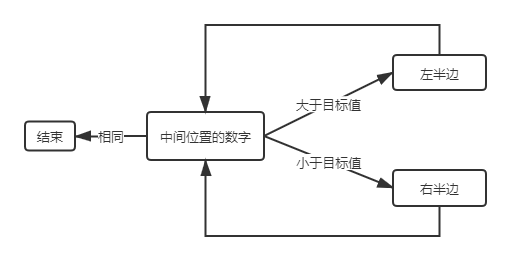二分查找
1 什么是二分查找
首先,我们来看 \(\color{purple}{线性查找(Linear Search)}\) 。对于一组无序的数字,想要从中查找某个数字的话就得从这组数字的头开始,依次往后比较,要么找到了该数字,要么找到了尾部都没有,那就是不存在这个数。上述过程就是线性查找,这组数字越长查找的性能就越差,时间复杂度为 O(n)。
是否有更好的查找方式呢?
二分查找就是。
如果我们拿到的是一组有序的数字,进行二分查找的方式是:首先比较 \(color{green}{中间位置}\) 的数字和目标是否相同,如果相同则结束查找,如果目标值小于中间位置的数字那么从左半边再找(查找步骤和上面一致),如果目标值大于中间位置的数字那么从右半边再找(查找步骤和上面一致)。

这个查找过程每次都直接缩减了一半的查找空间。现在来计算二分查找的时间效率:
\(color{purple}{最好的情况}\): 第一次直接在中间位置找到。
\(color{purple}{最坏的情况}\):找到了最后也没找到。那么查找的次数可以通过下面的方式计算:

长度为n为一组数字,累积的查找次数就是上面的1的个数,1的个数正好是n每次除以2直到为1的次数:\(log_{2}n\) 。所以二分查找的时间效率为O(log(n))。
2 python实现二分查找
找到要查找的元素则返回其索引,否则返回-1。
2.1 迭代实现
1 | def binary_search(array, target): |
2.2 递归实现
1 | def binary_search(array, target, low, high): |
3 基于二分查找的操作
3.1 Find First
二分查找能给出所要查找的元素的索引,如果要查找的元素在数组中出现多次呢?例如:[1, 3, 5, 7, 7, 7, 8, 11, 12],要查找7的话,二分查找给出的索引是4,如果我们想要得到元素第一次出现的索引呢?
思想:二分查找得到元素的索引,然后一步步向前找相同元素,直到找到不相同的元素或者找到头,返回相应的索引。
给定二分查找:
1 | def recursive_binary_search(target, source, left=0): |
Find First:
1 | def find_first(target, source): |
测试find_first: 1
2
3multiple = [1, 3, 5, 7, 7, 7, 8, 11, 12, 13, 14, 15]
print(find_first(7, multiple)) # Should return 3
print(find_first(9, multiple)) # Should return None
举一反三:如果想要找到元素最后一次出现的位置,只需要在上述代码中向后一步步查找即可。
Find Last:
1 | def find_last(target, source): |
测试find_last: 1
2
3multiple = [1, 3, 5, 7, 7, 7, 8, 11, 12, 13, 14, 14]
print(find_last(7, multiple)) # Should return 5
print(find_last(14, multiple)) # Should return 11
11